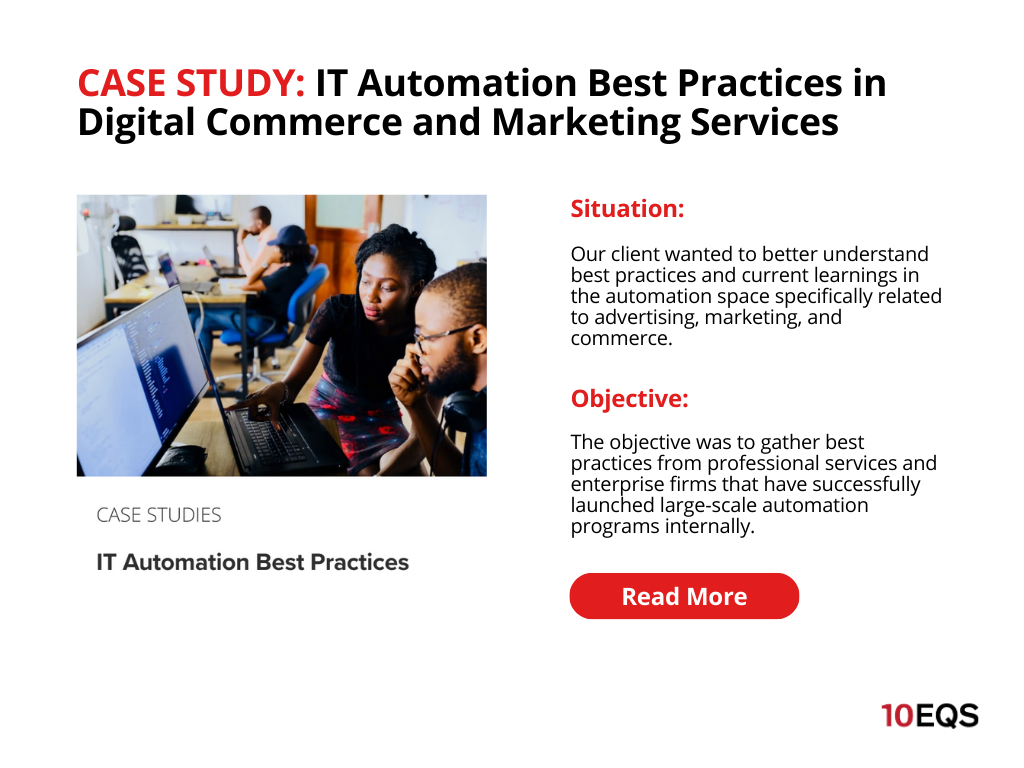At 10EQS, we engage with the world’s leading experts and consultants. Recently, we had the privilege of speaking with a Partner at a Venture Capital firm about the potential and opportunities within the generative AI market.
During our conversation, we explored the vast possibilities of the AI market, with one particular area of interest being the tremendous opportunities for generative AI to impact back office automation.
Inspired by this conversation, we decided to dive deeper into the potential opportunities and challenges companies could face when implementing generative AI for back office automation. This article will explore the opportunities and challenges of integrating generative AI into back-office automation.
And after reading this article, If you are interested in gaining a deeper understanding of back office automation and how it can benefit your organization, please contact us to discuss how we can support you with a customized benchmarking and best practices study.
Generative AI Provides Room for Growth
Automating manual, repetitive tasks in back-office operations has been transforming how companies operate for years, leading to improved efficiency, reduced costs, and increased accuracy.
However, traditional automation tools have limitations, and many companies are turning to generative artificial intelligence (AI) for the next level of automation.
As our expert explained, “With generative AI and these very large language models, you can start working in a much more open-ended way and open-ended problems.” This highlights the unique capabilities of generative AI in enabling more complex and open-ended problem-solving.
Powered by large language models, generative AI can understand and generate human-like responses, making it an ideal candidate for automating back office tasks that require nuanced decision-making and problem-solving.

Opportunities of Generative AI for Back-Office Automation
With the ability to process large volumes of data quickly and accurately, generative AI has the potential to revolutionize back-office automation and offer numerous benefits to companies that integrate this technology effectively.
Improved Efficiency and Cost Savings
By automating manual tasks, generative AI can help companies reduce operational costs and improve efficiency. For example, HR teams can use generative AI to automate repetitive tasks like employee onboarding, freeing time to focus on more strategic initiatives. In addition, generative AI can work around the clock, unlike human employees, which can further increase efficiency.
Enhanced Accuracy and Reduced Errors
Generative AI can also improve accuracy and reduce errors in back-office processes. For example, legal teams can use generative AI to review contracts and identify potential issues that human reviewers may have missed. Similarly, accounting teams can use generative AI to process invoices and identify errors that may have gone unnoticed.
Increased Capacity for Processing Large Volumes of Data
Generative AI can process large volumes of data quickly and accurately. This is particularly useful for tasks like data entry, where human error is common and processing large volumes of data can be time-consuming. Generative AI can help companies improve accuracy and reduce costs by automating these tasks.
Improved Decision-Making Through Data Analysis and Insights
Generative AI can also provide valuable data analysis and insights to improve decision-making. For example, finance teams can use generative AI to analyze data and identify trends or anomalies that may indicate potential risks or opportunities.
Challenges of Generative AI for Back-Office Automation
While generative AI offers many opportunities for improving back-office automation, there are also several challenges to consider.
Data Privacy and Security Concerns
As with any new technology, there are concerns about data privacy and security regarding generative AI. Companies must ensure that sensitive data is protected and that generative AI is used responsibly.
Regulatory Compliance and Legal Implications
There are also regulatory and legal implications to consider when using generative AI. For example, legal teams need to ensure that contracts are reviewed and analyzed accurately and that generative AI is not violating privacy or data protection laws.
Integration with Existing Systems and Processes
Integrating generative AI into existing systems and processes can be challenging for companies. The technology must be seamlessly integrated into existing workflows, and employees must be trained to use it effectively.
Potential Job Displacement and Ethical Considerations
Finally, there are potential ethical considerations and concerns around job displacement. While generative AI can improve efficiency and reduce costs, it may also lead to job loss for some employees. Companies need to consider the potential impact on their workforce and take steps to minimize any negative impact.

Use Cases for Generative AI in Back-Office Automation
Generative AI has many use cases in back-office automation that can help companies improve their efficiency, accuracy, and decision-making.
As the VC Partner points out, “On the back-office functions, I would say a lot of opportunity for automation with generative AI. Particularly in HR, legal, project management, and reporting. I do think there’s a lot of efficiencies to be gained because, for example, when negotiating NDAs and other contracts with customers, there are often many recurring transactions that have already been completed numerous times.”
As we continued to research use cases for back office automation, we discovered other opportunities for generative AI.
HR and Employee Management
Generative AI can automate many HR tasks, including employee onboarding, benefits enrollment, and performance management. This can free up HR teams to focus on more strategic initiatives, such as employee engagement and retention. For example, some companies use generative AI to automatically screen resumes and cover letters for job postings, saving time for HR personnel and improving the quality of hires.
Legal Document Review and Contract Analysis
Legal teams can use generative AI to review contracts and identify potential issues. This can improve accuracy and reduce the risk of errors while saving time and reducing costs. For instance, companies can use generative AI to automatically identify clauses that might be non-compliant or raise issues in legal contracts. This can also ensure that contracts are reviewed consistently, as opposed to being subject to the individual biases of different human reviewers.
Project Management and Reporting
Project management and reporting are often time-consuming tasks that require significant manual effort. Generative AI can streamline these processes by automating project tracking and reporting tasks, resource allocation, and budget management. For example, generative AI can help project managers to identify potential risks, suggest strategies to mitigate them, and optimize resource allocation to ensure projects stay on schedule and within budget.
Generative AI can also help identify potential risks and suggest strategies to mitigate them. This can provide project managers with more accurate and timely information, enabling them to make better decisions and deliver projects on time and within budget.
Financial and Accounting Processes
Finance and accounting are prime candidates for back-office automation with generative AI. Financial and accounting processes often require processing large volumes of data, such as transactions and invoices. Generative AI can streamline these processes by automating data entry, categorization, and reconciliation, freeing employees to focus on more strategic tasks. Additionally, generative AI can help organizations detect fraudulent transactions or identify areas for cost savings.
Generative AI can also improve decision-making in financial services by providing real-time insights into financial data. For instance, financial teams can use generative AI to analyze customer data and identify trends or anomalies that may indicate potential risks or opportunities. This can help organizations make more informed decisions about investments, risk management, and other financial activities.
Customer Service and Support
Generative AI can also enhance customer service and support in back-office operations. By automating tasks such as customer inquiries and complaints, organizations can improve response times and reduce the workload of customer service agents.
Additionally, generative AI can help organizations personalize customer interactions by providing insights into customer preferences and behavior. This can help organizations tailor their products and services to better meet the needs of their customers.
Best Practices for Integrating Generative AI for Back Office Automation
When integrating generative AI into back-office automation, companies must consider several challenges. As the VC Partner explained, “There is the compliance questions, privacy questions, regulatory questions, bias in data, bias in outcomes, all that kind of stuff you’ll need to address.” To minimize risks and maximize benefits, organizations should follow these best practices:
Identify the Right Processes and Tasks to Automate
Organizations should identify the processes and tasks most suitable for automation with generative AI. These should be repetitive, time-consuming, and require significant manual effort. By automating these tasks, organizations can improve their efficiency, accuracy, and overall productivity.
The VC Partner shared that it’s important to critically assess what a company aims to achieve before implementing generative AI. “Blindly automating or applying old processes to a new AI-enabled world is not advisable.”
Therefore, identifying the right processes and tasks to automate is critical for organizations to maximize the potential benefits of generative AI while minimizing potential challenges.
Address Privacy and Security Concerns Upfront
One of the biggest concerns with using generative AI in back-office automation is the potential for data privacy and security breaches. Organizations must be mindful of the sensitive nature of the data they are handling and take steps to ensure it is protected.
To address these concerns, companies should work with IT, professional services, and security experts to implement strong data security protocols, including encryption and access controls. Data should be stored securely, with limited access only to authorized personnel. Additionally, companies should regularly audit and review their security protocols to ensure they remain effective and current.
Develop a Strong Data Governance Framework
A strong data governance framework is essential for successful back-office automation with generative AI. Data management policies, data quality controls, and data access controls must be developed and implemented to ensure that data is used responsibly and ethically.
The data management policies should outline the types of data that will be collected, how it will be used, and who will have access to it. These policies should be reviewed and updated regularly to ensure they remain relevant and effective.
Data quality controls are critical to ensuring that the data used to train generative AI models is accurate and unbiased. It is essential to have strict quality control measures in place to ensure that data is properly labeled, cleaned, and validated.
Data access controls must be implemented to ensure that data is only accessible to authorized personnel. This can be achieved through access controls, such as passwords, biometric authentication, and other security measures.
Work with External Partners and Experts
Companies should work with external partners and experts specializing in back office automation and generative AI to ensure compliance with data privacy regulations and ethical considerations.
These experts can help companies navigate the complex regulatory landscape and develop ethical frameworks for the use of generative AI.
Continuously Monitor and Evaluate the System for Effectiveness and Improvements
Once generative AI has been integrated into back-office automation processes, it is essential to continuously monitor and evaluate the system’s effectiveness and make necessary improvements.
This can be achieved through regular audits and reviews of system performance and identifying areas for improvement. Feedback from employees and other stakeholders should also be considered to ensure that the system meets the organization’s needs.
Conclusion: Generative AI for Back Office Automation
Generative AI has the potential to revolutionize back-office automation by improving efficiency, accuracy, and decision-making. However, there are challenges to implementing this technology, including data privacy and security concerns, regulatory compliance, integration with existing systems and processes, and potential job displacement.
To successfully integrate generative AI into back-office operations, organizations must identify the right processes and tasks to automate, address privacy and security concerns upfront, develop a strong data governance framework, work with external partners and experts, and continuously monitor and evaluate the system for effectiveness and improvements.
By following these best practices, organizations can integrate generative AI into their back-office operations and gain a competitive advantage in their industries. The future of back-office automation with generative AI is bright, and companies that embrace this technology will be well-positioned to improve their operations and achieve long-term success.
Ready to explore the potential of generative AI for back-office automation? Contact us today to learn more about how we can help you maximize the benefits of generative AI.
